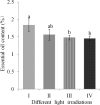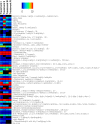Effects of light irradiation on essential oil biosynthesis in the medicinal plant Asarum heterotropoides Fr. Schmidt var. mandshuricum (Maxim) Kitag
- PMID: 32970685
- PMCID: PMC7514039
- DOI: 10.1371/journal.pone.0237952
Effects of light irradiation on essential oil biosynthesis in the medicinal plant Asarum heterotropoides Fr. Schmidt var. mandshuricum (Maxim) Kitag
Abstract
Asarum heterotropoides Fr. var. mandshuricum (Maxim) Kitag (Chinese wild ginger) is an important medicinal herb. Essential oil extracted from its roots is the key ingredient and is mainly composed of phenylpropanoid compounds. As a skiophyte plant, light is a crucial factor for A. heterotropoides var. mandshuricum growth and metabolism. To investigate the effects of light irradiation on the essential oil biosynthesis in A. heterotropoides var. mandshuricum, the plants were cultivated in four light irradiation treatments (100, 50, 24 and 12% full sunlight). The photosynthetic capacity, essential oil content and composition, activities of several enzymes and levels of some secondary metabolites involved in the shikimic acid and cinnamic acid pathways were analyzed. The leaf mass per area, average diurnal net photosynthetic rate, and the essential oil content increased significantly with increasing light intensity. Phenylalanine, cinnamic acid, and p-coumaric acid in the cinnamic acid pathway were at their highest levels in plants cultivated in 100% full sunlight. The highest content of shikimic acid in the shikimic acid pathway was obtained in plants grown in 50% sunlight transmittance. The activity of the enzymes 3-Deoxy-D-arabino-heptulosonate-7-phosphate synthase, phenylalanine ammonia lyase, cinnamate-4-hydroxylase and 4-coumarate:CoA ligase increased proportionally with light intensity. Overall, we conclude that high light irradiation promotes high net photosynthetic rate, high activity of enzymes and high amounts of phenylpropanoid precursor metabolites leading to significant biosynthesis of essential oil in A. heterotropoides var. mandshuricum.
Conflict of interest statement
The authors have declared that no competing interests exist.
Figures








Similar articles
-
Transcriptional response of Asarum heterotropoides Fr. Schmidt var. mandshuricum (Maxim.) Kitag. leaves grown under full and partial daylight conditions.BMC Genomics. 2021 Jan 6;22(1):16. doi: 10.1186/s12864-020-07266-7. BMC Genomics. 2021. PMID: 33407099 Free PMC article.
-
[Photosynthetic characteristics and active ingredients differences of Asarum heterotropoides var. mandshuricum under different light irradiance].Zhongguo Zhong Yao Za Zhi. 2019 Jul;44(13):2753-2761. doi: 10.19540/j.cnki.cjcmm.20190504.101. Zhongguo Zhong Yao Za Zhi. 2019. PMID: 31359687 Chinese.
-
[Composition analysis of volatile oil of Asarum heterotropoides var. mandshuricum extracted by three different methods].Zhong Yao Cai. 2013 Sep;36(9):1447-51. Zhong Yao Cai. 2013. PMID: 24620691 Chinese.
-
[Effect of light intensity on growth and quality of Asarum heterotropoides var. mandshuricum].Zhongguo Zhong Yao Za Zhi. 2011 Jun;36(12):1558-67. Zhongguo Zhong Yao Za Zhi. 2011. PMID: 22007533 Chinese.
-
The Effect of Auxin and Auxin-Producing Bacteria on the Growth, Essential Oil Yield, and Composition in Medicinal and Aromatic Plants.Curr Microbiol. 2020 Apr;77(4):564-577. doi: 10.1007/s00284-020-01917-4. Epub 2020 Feb 20. Curr Microbiol. 2020. PMID: 32080752 Review.
Cited by
-
Antimalarial efficacy and toxicological assessment of medicinal plant ingredients of Prabchompoothaweep remedy as a candidate for antimalarial drug development.BMC Complement Med Ther. 2023 Jan 18;23(1):12. doi: 10.1186/s12906-023-03835-x. BMC Complement Med Ther. 2023. PMID: 36653791 Free PMC article.
-
Transcriptional response of Asarum heterotropoides Fr. Schmidt var. mandshuricum (Maxim.) Kitag. leaves grown under full and partial daylight conditions.BMC Genomics. 2021 Jan 6;22(1):16. doi: 10.1186/s12864-020-07266-7. BMC Genomics. 2021. PMID: 33407099 Free PMC article.
-
Comparative Analysis of Volatile Compounds and Biochemical Activity of Curcuma xanthorrhiza Roxb. Essential Oil Extracted from Distinct Shaded Plants.Plants (Basel). 2024 Sep 25;13(19):2682. doi: 10.3390/plants13192682. Plants (Basel). 2024. PMID: 39409552 Free PMC article.
-
Potential Importance of Molybdenum Priming to Metabolism and Nutritive Value of Canavalia spp. Sprouts.Plants (Basel). 2021 Nov 5;10(11):2387. doi: 10.3390/plants10112387. Plants (Basel). 2021. PMID: 34834749 Free PMC article.
-
Effect of Elevated CO2 on Seed Yield, Essential Oil Metabolism, Nutritive Value, and Biological Activity of Pimpinella anisum L. Accessions at Different Seed Maturity Stages.Biology (Basel). 2021 Sep 29;10(10):979. doi: 10.3390/biology10100979. Biology (Basel). 2021. PMID: 34681078 Free PMC article.
References
-
- Zhu Y.P. Chinese Materia Medica; Chemistry Pharmacology and Applications. 1988, Florida, USA: CRC Press.
-
- Haque A.S.M.T.; Moon J.N.; Saravana P.S.; Tilahun A.; Chun B.S. Composition of Asarum heterotropoides var. mandshuricum radix oil from different extraction methods and activities against human body odor-producing bacteria. J. Food Drug Anal. 2016, 24, 813–821. 10.1016/j.jfda.2016.04.006 - DOI - PMC - PubMed
Publication types
MeSH terms
Substances
LinkOut - more resources
Full Text Sources
Research Materials

